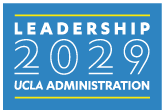Management Topic: Goal Setting and Professional Development
Dear Colleagues,
As managers, our most important responsibility is guiding the performance and professional growth of our direct reports and team members. To establish an environment and working relationship where staff can thrive and develop – regardless of whether they are working remotely, on campus, or in a hybrid fashion – a manager must be deliberate and consistent with how they provide this guidance. This month, we will examine eight key actions to implement when setting performance goals with your staff. We will also explore how to provide meaningful professional development opportunities for your direct reports as they progress in their roles. Finally, we have provided some tools to help organize the ongoing dialogue that you'll be having as you manage your staff.
Making Work Goals Meaningful
Connecting the goals of the university and your department to the goals you set with your staff can be the biggest challenge for a manager, but without some link to high-level strategic goals, staff often think that their contributions are not impactful or less meaningful. The ideal is that each staff member sees how their work drives the department and university forward in a positive way, is inspired by the goals they have set with you, and has a clear understanding of what their objectives and key results (OKRs) will be for the year. Here are eight actions that can help you approach that ideal:
- Set aside at least one hour to discuss and collectively agree upon the goals you are setting with your direct report. This should be done at the very beginning of the performance period or within the first month if the employee is new to the organization. Both parties have homework – the manager should craft a reasonable set of objectives to propose and the employee should review any past performance feedback and their current job duties. It's helpful to work together to identify the key results that will indicate success in achieving the objectives – this gives the employee a chance for valuable input and ownership of their goals.
- Familiarize your staff with your department’s relevant strategic plans and highlight ways that their performance objectives and key results might fit into the trajectory of your organization.
- Have your staff reference their job description to ensure that the proposed goals are within the scope of their official duties – but be willing to consider stretch goals if they are appealing to the employee, foster professional growth, and still meet the needs of your department.
- Utilize the SMART methodology when writing goals so they are Specific, Measurable, Achievable, Relevant and Time-bound.
- Try to include opportunities for growth within the performance goals, such as projects working with staff from different divisions, goals that use skills the employee seeks to improve upon or gain, and assignments that allow them to work with potential mentor figures.
- Keeping a good balance of goals, leveraging strengths, and improving areas that need development will allow your employee to demonstrate their skills while also developing new ones.
- While 1-year goals are the most common, be flexible in considering longer timelines for highly impactful, complex, or ambitious goals, or shorter goals for new employees or those whose job environment could potentially change in the near future.
- Document their goals using your department’s agreed upon Performance Assessment Tool (or equivalent) and make it a point to reference and update the document at all your one-on-one meetings with your employee.
Professional Development Planning

A commitment to professional development is key to a successful, dynamic organization. Leadership must invest in their staff through resource allocation, rewards & recognition, and provide support for those engaging in professional growth opportunities in order to maintain a steady pipeline of developing talent on the team. Providing professional development opportunities not only helps existing staff gain new skills, but it also helps the organization fill vacant roles –either by using it as an incentive for new hires or by preparing current employees to successfully move upwards in the organization as vacancies arise. Here are some ways you can incorporate professional development into your management process:
- Create a curated list of available professional development opportunities, that is categorized and easily searchable, with relevant information such as duration, cost, and prerequisites. There are many options available and doing a broader search, while potentially helpful in finding new things to add to the list, can also leave staff feeling directionless or overwhelmed if they are not sure about what they want to pursue. Putting the time into narrowing down those opportunities so that they’re all appropriate for your department’s staff will improve accessibility. Environmental Health & Safety (EH&S) has provided a copy of their Career Development Opportunities Catalogue as an example for reference.
- Some excellent courses and programs are offered free or at low cost by UCLA – take advantage by highlighting these opportunities for your staff. Campus Human Resources offers individual courses, certificate series, and year-long leadership programs such as the Professional Development Program. More information regarding the plethora of programs available to staff can be found on the CHR Learning & Organizational Development website. Within UCLA Administration, Organizational Effectiveness & Development also offers leadership and career development programs and resources, including the UCLA Leadership Administration 20XX Program. UCLA campus organizations like the Administrative Management Group (AMG) also offers programs and workshops on professional development. AMG offers ProShare, a networking and support program to all UCLA staff.
- Add additional opportunities to the curated list by periodically soliciting feedback from staff on activities and courses they engaged with over the past quarter or year. This will create a pipeline of new opportunities that come with staff feedback so your employee can make an informed decision when considering the opportunity.
- When planning professional development with your staff at the mid-year point, document short-term and long-term ambitions, a strength and weakness breakdown, and a schedule for tracking their participation in the chosen opportunities. EH&S has provided their template as an example.
- Not every professional development opportunity your employee participates in needs to be directly applicable to their current job – growth within their current role should certainly be a priority if there are gaps, but a major focus should also be on the next phase of their career. Candid conversations can identify whether or not the employee is more interested in gaining additional technical proficiency, leadership experience, or new skills unrelated to their primary duties for an anticipated pivot into a different role, division, or department. As a manager, your job is to listen, support, and set them up for success on the path they choose.
- As with the setting of performance goals, establishing professional development goals is only the beginning. Progress must be discussed regularly, and strategies adjusted as conditions change. We recommend quarterly check-ins with your staff to make sure they are progressing with their professional development activities and that their work performance is seeing the benefits of those activities.
- Providing time (e.g. two hours per week) for staff to not only engage with professional development opportunities but also share what they’ve learned and achieved with their colleagues, creates an expectation for continuous improvement and gives employees a chance to celebrate these achievements while they learn from and inspire each other. Set the expectation that staff will 'report back’ via group presentations, lessons learned, or recaps of their experiences when relevant to the rest of the team.
Next Steps
Many guides and resources on how to write SMART goals, conduct goal setting meetings, and track professional development are available here at UCLA. Examples of curated professional development catalogs are also available upon request.
As with any collaborative experience, getting your partners (in this case your direct reports) to buy into the process is paramount. If you take it seriously and follow-through on the process, then that opens the door for them to do the same. Be consistent and deliberate and success will follow.
Helpful Tools to Learn More About This Topic:
- SMART Goals (2 minutes, 42 seconds)
- Managers, here’s how to keep your employees on track with their goals (Article)
- Working on Shared Goals Through Teaming (4 minutes, 49 seconds)
Scenario for Discussion:
Your assistant, a Blank Assistant 3, comes to you and shares their interest in learning more about various types of reporting and analyzing data. You are excited with their enthusiasm to learn, and their initiative and begin to prepare additional tasks for them to learn and develop these skills.
- What factors should you consider when developing and assigning these additional job duties?
- If you have questions regarding developing these skills, whom could you contact?
- What courses could you assign to ensure their success and where would you look for these courses first?
- What steps should you take after providing this individual a few tasks in this area?
*Recommendations for how to appropriately address this scenario will be provided in next month’s newsletter!
Interested in reviewing prior months’ topics? Visit our Monthly Management Tips website.
Stay Safe!

Do you have feedback, questions or a suggested topic you would like to learn more about? Please email: managementtips@ucla.edu.
Want to receive Monthly Management Tips emails? Sign up for our list!

